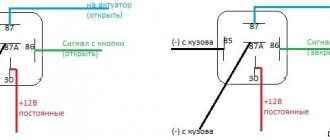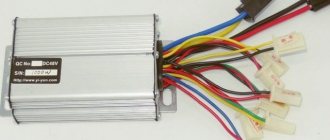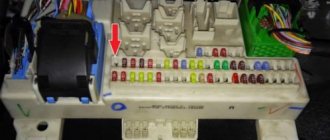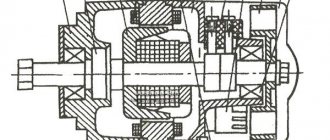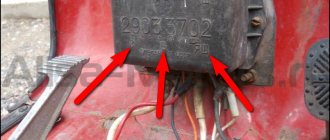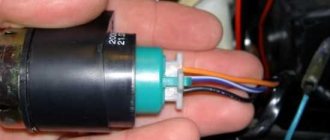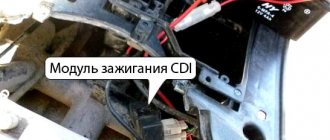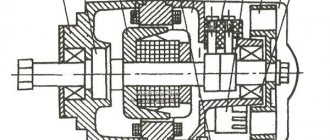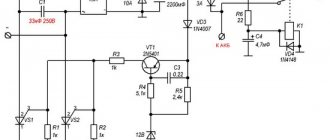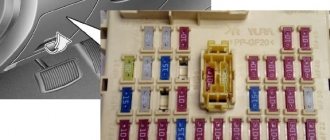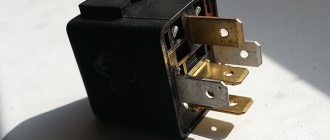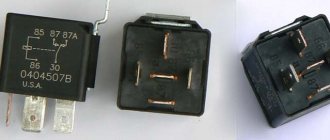Standard Lanos fuses from Chevrolet are located in three independent blocks. Each module is responsible for its own portion of wiring and equipment. In the CIS countries the car is produced under the Deo brand. The location of the main elements and the design of the car are no different. The first mounting block is located in the engine compartment and has a narrow purpose - protecting the main electrical equipment responsible for the operation of the power plant. The second unit, like that of Daewoo Lanos, is installed in the cabin under the driver’s feet. Only fuses are mounted here. The third part is located under the dashboard.
All structural parts have relays and fuses. Interchangeability of components is possible only if they are completely consistent.
Working principle of a car fuse
The components of automotive fuses are elements such as a body and a fuse link. Chevrolet and Daewoo Lanos vehicles are equipped with flag or plug-type devices. The body of such devices is made of plastic. The fuse link is located inside the housing, which does not necessarily have to be sealed. Two contacts (legs) protrude from the body, through which the part is installed in the electrical circuit of a certain device.
The most important parameter of a fuse is the amount of current it is designed for. All devices are designed to protect electrical wiring from fire, as well as prevent failure of electrical appliances. In simple terms, a fuse protects electrical equipment from short circuits and the flow of high current. High current can lead to melting and subsequent spontaneous combustion of the wiring.
The fuse link of the element is designed for a certain amount of current, which depends on the power of the pantograph (electrical equipment). As soon as the current in the circuit exceeds the rated value for which the fuse is designed, the fuse-link burns out. As a result, the circuit opens, thereby preventing melting of the wire insulation and failure of electrical appliances.
Once a fuse has tripped, it cannot be repaired and must be replaced with a similar current rating. It should be installed in place of the failed element only after the cause of the device’s operation has been identified. If, when replacing a failed fuse, you install a device with a lower or higher current strength, this will lead to the following situations:
- If the current is below the rated current, the device will trip when electrical appliances are turned on
- If the current is higher than the rated current, the fuse will not work, which will lead to melting of the insulation, as well as failure of the electrical appliance.
The rating of the protective element is indicated on the front side of the product. Additionally, manufacturers produce devices that vary in color. The color corresponds to the current strength for which the protective device is designed. Below is a table showing the device rating depending on color.
Using a table with colors is very convenient when the fuse rating is not visible. If you don’t know what rating a protective element should have in a circuit with a particular electrical appliance, then you shouldn’t guess. You can calculate it or use the information provided below.
Lanos central locking relay: repair
The reasons for part failure may be related to moisture ingress and intense shaking. If the relay is broken or has failed, it needs to be replaced entirely. The part cannot be repaired.
Standard Lanos fuses are located in convenient places and are easy to change. To repair the device, you will need to find the damaged element and replace it with a known good one.
Specialization: Graduated from the State Automobile University, worked for 20 years at GAZ-56, now I drive a Zhiguli.
Chevrolet Lanos is a budget car. However, despite this feature, the sedan is not without on-board electronics, which controls some of the components. Moreover, the car has several fuse blocks: in the Chevrolet Lanos these devices are located in the engine compartment and in the passenger compartment. The type of equipment that these components protect depends on this localization.
Where are the fuses on Chevrolet and Daewoo Lanos?
One of the main questions that all car owners ask is where the fuses are located. Before diagnosing the power circuit of a particular non-working electrical appliance, you should first find the required fuse. There are three places on Lanos where these devices are located. We will find out more about their location below.
Lanos have three fuse and relay blocks. Their locations are not known to all car owners, so we present information with photos:
- Block in the engine compartment. If you remove the cover of the unit, you will find the presence of not only protective devices, but also relays. This block is the main one, since this is where the devices responsible for protecting the ignition switch circuit are located
- Block in the cabin near the driver's feet. This block contains only fuses without relays. This block contains protective devices included in the circuit of interior electrical appliances - interior lighting, hazard warning lights, radio, ECU power supply, dimensions, etc.
- Relay box under the instrument panel. To gain access to it, you need to remove the decorative plug on the side of the dashboard or remove the panel of the headlight electric corrector unit. This unit is equipped with relay only
- An additional fuse is installed on the right side near the passenger's feet. It should be noted that this element was not installed on all Lanos cars, but only on those with an ABS anti-lock braking system. Its rating is 10A
- Additional relays are also installed under the hood of the car on the left side near the engine compartment
Knowing where the fuse and relay blocks are located on Chevrolet and Daewoo Lanos, you need to figure out which electrical appliances they are responsible for protecting and operating.
Daewoo Lanos Fuse location
YouTube fuse boxes and fuses for Lada Largus
Location of fuses
Fuse locations may vary depending on model. The location of the fuses is shown on the fuse box cover and also in the vehicle owner's manual.
From 9/85 to 9/89 issue
The fuses are located in a box in the left footwell.
| The main fuses are located in a box in the engine compartment, in front of the left shock absorber housing. |
Fuse location
| Consumer | |
| 1 | Power window |
| 2 | brake lights, horn |
| 3 | engine control |
| 4 | compressor motor (ride height adjustment)* |
| 5 | devices |
| 6 | rear window defroster |
| 7 | tail lights |
| 8 | radio, cigarette lighter, mirror adjustment |
| 9 | rear fog lights |
| 10 | headlight washer |
| 11 | central locking device |
| 12 | interior lighting |
| 13 | air conditioner |
| 14 | transfer case lock* |
| 15 | Luke |
| 16 | windshield wiper and washer system |
| 17 | fan motor |
| 18 | rear wiper |
| 19 | heater fan |
* - only on vehicles with all-wheel drive
From 10/89 issue.
| The fuses are located in a box in the left footwell. |
The main fuses are located in a box in the engine compartment in front of the left shock absorber housing.
Fuse location
| A* | Consumer | |
| A | 15 | rear window washer, washer pump |
| B | 10 | sound signal |
| C | 10 | interior lighting, trunk lighting |
| D | 15 | engine control |
| E | 15 | radio, clock, cigarette lighter, electric mirrors |
| F | 30 | central locking device |
| G | 10 | rear right side light |
| N | 30 | electric windows |
| I | 15 | instruments, reversing lights, direction indicators |
| J | 20 | windshield wiper, washer pump |
| K | 15 | seat heater |
| L | 15 | rear left side light, parking light, instrument lighting, license plate light |
| M | 15 | Luke |
| N | 10 | anti-lock braking system (ABS) |
| O | 15 | daytime driving light |
| P | 30 | headlight washer |
| Q | 30 | heater fan |
| R | 10 | left low beam |
| S | 10 | right low beam |
| T | 10 | left high beam |
| U | 10 | right high beam |
| V | 10 | rear fog lights |
| W | 10 | anti-lock braking system |
| X | 30 | rear window defroster |
* - A = amperes
Fuse box in the engine compartment
| A* | Consumer | |
| 1 | 30 | fuel injection system |
| 2 | 30 | alarm |
| 3 | 80 | main fuse |
| 4 | 60 | hazard warning lights, interior lighting, central locking, brake and tail lights, generator |
| 5 | 60 | anti-lock braking system |
| 6 | 30 | fan |
| 7 | 20 | air conditioner fan |
| 8 | 10 | brake lights |
| 9 | 10 | engine control device |
| 10 | 30 | headlight leveling motor (hatchback only) |
* - A = ampere
Fuse and relay box under the hood on Lanos
This block is located on the right side when you open the hood. It is closed with a plastic lid, which ensures tightness. The lid is secured with latches. Under it there are not only fuses, but also relays. For easy removal of fuses, there is a special plug. Below in the photo is the digital designation of devices, the decoding of which is in the table.
Fuse element F1 protects the power supply circuit of fuses F1-F7 and F15-F20. F12 - used on cars with air conditioning. Protects the electrical clutch circuit of the air conditioner. F15 is an air conditioning compressor clutch relay diode. F19 - protects the power supply circuit of the brake light, electric headlight adjustment, exterior lighting on the left side, corrector illumination, clock, rear fog lights, ashtray lamp, radio and air conditioner illumination. F20 - additionally protects the power supply circuit for the right headlight and license plate lights.
In the table above, relay R3 is used on Lanos cars with air conditioning. This relay is responsible for the operation of the electrical clutch of the air conditioning compressor. R4 - this element may also not be used if there is one fan on Lanos, Sens or Chance. He is responsible for turning it on. R5 - turns on the front fog lights if the car has them. R11 - relay for turning on the cooling fans at first and second speed.
Causes of malfunction
Now that we know how the fan radiator works, we can move directly to the issue of identifying the reasons for its failure. So, let's look at what causes the node to not turn on:
Breakdowns in wiring or handicraft repairs.
- Fuse failure.
- Broken power and control wires.
- Oxidation of wire connection pads.
- Relay.
- Temperature sensor.
- ECU.
Fuse box in the car interior on the left under the trim
The interior fuse box of Lanos, Sens and Chance is responsible for protecting various electrical equipment. There are 20 fuses located on this block in the passenger compartment. Let's look at their purpose in detail.
The table below provides not only a description of the purpose of each element, but also the maximum current value. When searching for or replacing cabin fuses on a Lanos, you must rely on the data from the table.
Fuse F2 is responsible for turning off the rear PTF lamps. It also protects the power supply circuit for the headlight range control and the door open alarm. F5 - protects the power supply circuit of the vehicle's ECU. The power cable comes directly from the battery. Fuse F8 on the block is responsible for supplying power to the light alarm on the driver's door. Element F13 is responsible for the proper operation of the airbags. F15 - supply voltage to the coil or ignition module. F20 - battery for the electric heater motor for speeds 1-3.
Radiator fan device
Before moving directly to the causes and methods of solving the problem, it is necessary to understand the design features of the unit.
Cooling system design: diagram
1 — electric fan; 2 — electric fan casing; 3, 34 - nuts; 4, 7, 9, 10, 12, 13, 15, 17, 18, 20, 25, 27, 30, 32, 36, 38, 39, 41, 43, 45 — clamps; 5, 28, 46, 47, 50 - bolts; 6 — supply hose for heating the throttle assembly; 8 - tee; 11 — heater supply hose; 14 — bypass hose; 16 — heater outlet hose; 19 — outlet hose for heating the throttle assembly; 21 — thermostat housing; 22 — sealing ring of the thermostat cover; 23 — thermostat; 24 — water pump pipe; 26 — water pump outlet hose; 29 — connecting pipe; 31 — liquid hose of the expansion tank; 33 — expansion tank; 35 — expansion tank plug; 37 — steam outlet hose of the expansion tank; 40 — radiator supply hose; 42 — radiator; 44 — radiator outlet hose; 48 — radiator mounting bracket; 49 — upper radiator mounting pad; 51 — lower radiator mounting pad.
Relay block under the torpedo Lanos, Sens and Chance
Behind the control panel for the headlight range control of Lanos, Sens and Chance cars there are four relays responsible for the operation of the rear fog lights, direction indicators and hazard lights, heater fan and windshield wipers.
Under number “1” in the photo above there is a relay that is responsible for the operation of the electric heater motor, which is turned on at 4 speeds. If the stove stops working in position 4, then you need to check the serviceability of the relay. Number “2” is the device responsible for the operation of the car’s turn relay and hazard warning lights. Number “3” is the relay responsible for the operation of the windshield wiper, which operates in intermittent mode. Number “4” is the rear fog lamp relay on Lanos, Sense and Chance.
Separately, it should be noted that under the hood there are two more or one relay, which depends on the year of manufacture of the car. The devices are located on the left when the hood is opened near the engine shield. One element is responsible for sending a signal to start the engine, and the second is intended to control the operation of the generator. The relay supplies power to the generator integrated board.
This is interesting!
Short-circuiting relay contacts directly without using the device is strictly contraindicated. This will not only lead to the fuse tripping, but also the failure of electrical appliances.
Chevrolet Lanos dashboard description
Chevrolet Lanos dashboard
The location of all devices is shown in the figure above. Next, let's talk about what each device means.
1. A light indicating engine overheating. If the engine overheats, the indicator will glow red. If this light suddenly comes on, you need to stop and let the engine cool, and also eliminate the cause of the overheating and, if possible, eliminate it.
2. Oil pressure lamp. If the oil pressure in the system drops, this light will turn red and you will need to stop to add oil.
3. Airbag light. If the airbag is not working properly, then when the engine starts, this light will turn red. We recommend that you immediately contact a service center to fix the problem, since the airbag may not only not work in an emergency, but also shoot out just like that while driving, which will provoke an emergency.
4. Coolant temperature indicator. If the arrow approaches the red zone, this is a signal that the light will soon light up, indicating that the engine is overheating.
5. A light indicating the operation of the rear fog lights. Lights up yellow.
6. Left turn signal light. When the left turn is turned on, it lights up green.
7. Low fuel level lamp. This light turns yellow when there is less than 7.5 liters of fuel left in the fuel tank.
8. Speedometer. This device shows the speed of the vehicle. Each scale division corresponds to 10 kilometers.
9. Odometer. Shows how much the car has traveled over the entire period of its operation.
10. High beam light. Lights up blue when the driver turns on the high beams.
11. Right turn lamp. Lights up green and flashes when right turn is engaged.
Read also: How to check a removed hall sensor
12. Fog lamp. Lights up green when the fog lights are on.
13. Fuel level indicator in the tank. We recommend that you always keep the gasoline level above red. The fact is that if you drive on a reserve liter of gasoline, there is a high probability that the gas pump will soon fail.
14. A light indicating a malfunction of the anti-lock braking system. In case of breakdown, glow yellow.
15. A light indicating that the doors or trunk are not closed. This way you will definitely not forget to close the doors and trunk lid tightly.
16. Kick Down mode indicator. Only works on vehicles equipped with an automatic transmission.
17. Brake system light. If there is too little brake fluid left, it will light up red.
18. Engine control lamp. It should light up when the ignition is turned on, and then go out smoothly. If the light goes out or comes on for no reason while driving, this means that there is something wrong with the engine.
19. Daily mileage button. When pressed, it resets the mileage accumulated over a certain amount of time.
20. Daily mileage counter. In fact, it can count more than a day, and you can reset it at any time. A great thing for measuring distance and fuel consumption.
21. Battery light. If the battery is low, it will light up red.
22. Seat belt lamp. If the driver or passenger is not fastened, the light will turn red.
In a Chevrolet Lanos car, the instrument panel lights are all marked with characteristic patterns, so it is very difficult to confuse them. The panel is really simple and clear, even without these instructions you can figure it out without any problems.
The Lanos car belongs to the category of budget vehicles, but at the same time it is quite reliable and comfortable. Comfort in driving a car depends not only on comfortable seats, but also on the information content of the dashboard. The Lanos's dashboard contains all the most important elements. Some drivers still do not know the purpose of certain elements on the Lanos dashboard. If you are one of them, then it's time to understand all the notations.
What is a relay and its purpose on a car
An element such as a relay on a Lanos, Sense and Chance car is designed to close and open electrical circuits. In simple terms, these devices supply power to powerful electrical appliances through small buttons.
If you do not use a relay, and, for example, start the engine directly, then the contacts in the ignition switch will immediately burn out or the button will melt. This is due to the fact that when starting the engine, the starter consumes a very large current, which, when passing through the ignition switch contacts, would melt them.
To avoid making the on and off buttons massive, relays are used in cars. These are a kind of protective devices that divide the circuit into high-voltage and low-voltage. The devices have a simple design, and their main element is a coil with a winding. When using a relay, it is important to understand the purpose of its contacts:
- 85 and 86 - coil contacts
- 30 - common, which is supplied with constant power from the battery
- 87 - normally open contact or power supply to the receiver
- 87a - normally closed contact, which is also called additional
When replacing a relay, it is important to pay attention to which element was previously in the socket - three, four or five-pin. Replace only with a device of similar design.
Procedure for checking an electrical relay
You can find out the reason why the fuel pump stops working by checking its switching circuits, which includes a relay. It is an electrical device that, at the command of the electronic power supply, provides power to the pump motor, and when the contacts open, it stops this supply. Its malfunction is often associated with a breakdown of its coil or due to oxidation or burnt contacts that will need to be cleaned.
The Chevrolet Lanos fuel pump relay, where the control and controlled part (contact group) is located, as well as the fuses, is located in the mounting block of the engine compartment - in the right front corner.
To check the serviceability of the K9 relay, you will need instruments such as a multimeter or test light, a probe and a piece of wire. However, if the fuel pump is not working, first of all, it is recommended to check the serviceability of fuses F17 and F16, typical for Chevrolet Lanos. How to check the fuel pump relay is a frequently asked question, and the answer is quite simple - you just need to use one of the methods below.
- First, you will need to remove the device from the mounting block and replace it with a working type, for example, relay K7 (for power windows). Turning on the fuel pump with an alternative relay indicates a faulty relay. If it does not turn on, we check the power and control circuits of the electrical device.
- If there is no spare working relay, a similar method above to check the serviceability of the device is to install a jumper (a piece of wire, a paper clip) between contacts 30 and 87, which will close them when the ignition is on.
- You can determine whether the device needs to be replaced by measuring the voltage between pin 86 and ground (minus). When the ignition is on, it should be equal to 12 V. We also check the voltage between pin 30 and ground. It is equal to the on-board network voltage. Its absence indicates a break in the wires between the contacts and ground. Otherwise, you need to connect the probe between pin 85 of the relay harness block and the positive terminal of the battery. If the probe lamp does not light up when the ignition is turned on, this indicates a malfunction of the controller or a broken wire. If the lamp comes on, it indicates the need to replace the electrical device.
- Also, using a tester in ohmmeter mode between pin 85 and the vehicle ground, you can measure the resistance, which if the circuit is working properly should be 1 ohm.
Car enthusiasts who are interested in this model can find out how much the new Chevrolet Lanos costs on various Internet sites. The price of a new sedan varies from 250 thousand rubles. and higher depending on the configuration: basic S, medium SE and maximum SX.
Tips for motorists
Closer to 40 thousand kilometers of a Chevrolet Lanos passenger car, problems appear with the operation of the direction indicators. At first they start to turn on as they “want”, sometimes they blink a couple of times and stop working, and sometimes they work normally. But this does not last long; subsequently, the direction indicators stop turning on altogether.
The culprit for this malfunction is usually the hazard warning relay, which should ensure the blinking of the direction indicator lamps. In order to find it and replace it, you need to open the left front door of the car, which opens access to the cover of the mounting block located at the end of the front panel. If you remove it and move the headlight range control outward, then inside you will see 4 relays, on the top of the housing there are symbols of the electrical circuits in which they operate. You need to replace the relay with the hazard symbol symbol. It is advisable to purchase and install a relay (2x21+3)x2W 495.3747, which is manufactured in Kaluga.
If such a malfunction occurs far from the nearest spare parts store, then remove this relay from the block, and place a metal jumper between contacts 49a and 49. Then, using your left hand, you can make the turn signal lamps blink if you use the turn signal switch lever to turn them on and off. Although the Traffic Rules provide for hand signals when making turns, unfortunately, not all drivers remember this. Therefore, it is better to follow this recommendation to avoid getting into an accident.
When the direction indicators stop working without any preliminary “glitches,” you will have to start troubleshooting by checking the fifteen-amp fuse F16. It is located in the mounting block on the left side of the body in the area where the driver’s feet are located, and the color of this fuse is blue.
Another turn signal malfunction occurs when one of the lamps burns out. In this case, the blinking frequency of those lamps that are still intact doubles. This means that the load on the turn signal relay doubles, which sharply reduces its service life, leading to breakdown of the moving contact of the electromagnet. Therefore, a burnt-out turn signal lamp must be replaced as quickly as possible. Moreover, the power of the new lamp should be similar to the one you are replacing.
Trouble happened this morning, turn signals and emergency lights
. And they suddenly disappeared in the city center. It’s still not a straight road to work) They were working here and immediately stopped.
What did I do to quickly fix this problem? Immediately, let’s press the button 1000 times, pull the switch and silence. Nothing blinks or appears on the dashboard. I made a mistake on the hazard warning button. The connector in mine had long been burnt and cracked. Why is still a mystery. In short, I bought a button for 120 UAH. I connect and again nothing. I immediately remember that there is a switch for the emergency lights, before that I looked at all the previous ones - they are all intact. I run to the store again and buy the one I had, from 8 = 67 UAH. She clicks more quietly. I connect a new relay and again nothing. Yes yes! - I said to myself. Distressed, I’m on my way to work, although waving my hands to the left/up according to traffic rules))) I Googled a lot, looked at what and how. Everything is simple for everyone, either a fuse or, in most cases, a relay.
